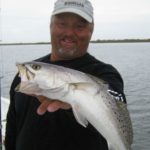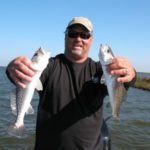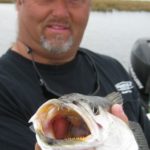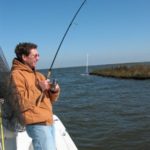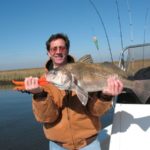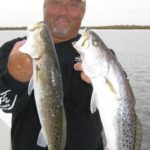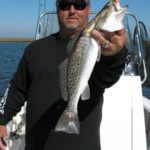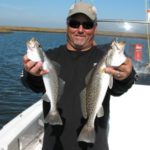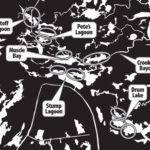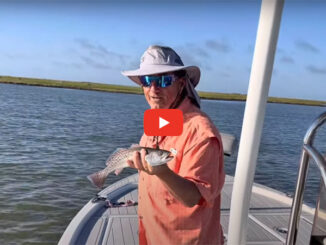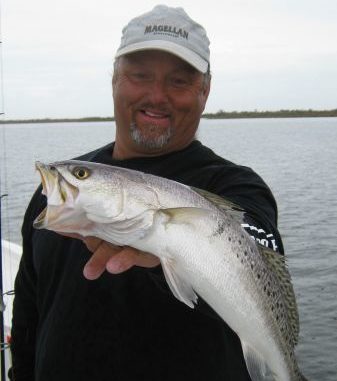
Water temperatures might be falling this month as winter really sets in, but that doesn’t mean you should sit at home. Instead, head to in the Biloxi Marsh to fill the box with trout and reds.
According to the Biloxi Marsh Lands Corporation, the Biloxi Marsh is an estuary network of 210,000 acres of coastal wetlands. That network was crushed by Katrina, and battered and bruised by countless hurricanes and tropical storms before and since.
It was injured by BP, and given a severe thrashing for years by the greatest debacle in the history of the Corps of Engineers — the MRGO.
Yet, marvel of marvels, that marshland survives, and even thrives. Crisscrossed by bayous and canals, dotted with innumerable lakes, bays, ponds and lagoons, it provides a rich variety of habitat that offers for some of the best coastal fishing anywhere on earth.
The trout and redfish action has been outstanding the last few months, and January should hold more of the same.
I recently asked Capt. Casey Kieff (504-512-7171) to pilot my recently acquired (used) 24-foot Triton Bay Boat on a foray into that vast wetland to see if we could Christen it with fish slime. I figured if our inaugural trip was successful, it’d bode well for future excursions.
Kieff agreed, and we put a day on the calendar. Unfortunately, we had to cancel that trip due to strong winds. Then we cancelled the next two dates for the same reason.
Finally, it looked like we’d finally get a break from the winds, so we headed out.
But there was a catch: It was cold. In fact, cold and wet.
When we pulled up to the dock at Campo’s Marina in Shell Beach to buy some live bait, we talked to another charter captain whose customers had just cancelled their trip with him for the day because of the rain.
“Did you see the radar?” he asked us incredulously.
Shaking our heads that we hadn’t, we pulled out the smart phones, tapped the radar icon, and lo and behold a solid wall of rain was heading our way — and from the look of it, it’d be on us within the hour.
Decision time! We had a bunch of us aboard, and we discussed the options. Do we go back to the camp and wait out the rain? But from the looks of the radar and the forecasts, the rain would hang with us all day. Do we blow the trip off, again, and go home?
Kieff settled our quandary: “Did y’all bring rain suits? It just looks like rain; no lightning, no big thunderstorms.”
So it was settled. We headed toward the Biloxi Marsh, huddled against the cold, and prepared for the wet.
One of my fishing buddies mumbled something like, “You have to hate speckled trout pretty bad to go out to kill them in this weather.”
It’s a four- or five- mile trip down the MRGO from Shell Beach to Bayou LaLoutre, and then about eight miles to our turn into the Drum Hole.
Kieff had been on a pretty good bite in Drum Lake, which is behind the Drum Hole. The challenge is getting across the shallow Drum Hole to pick up the deeper bayou on the other side when the tide is low.
“The key is to get up on top and go straight across,” Kieff said. “It’s very shallow on either side, so don’t stray off course; head straight to the bayou on the other side.
“And if the tide is real low, don’t try it, unless you’re familiar with the area and positive you can make it.”
The tide wasn’t exceptionally low like it can get in winter, so he ran the jack plate all the way up and headed straight across, and I watched the mud kick up along the way until we hit the deeper bayou on the way to Drum Lake.
The south side of Drum Lake has a lot of broken marsh, small islands, pockets and drains from the marsh, and some deep channels or bayous funneling off toward the east and Flat Bay. It’s prime habitat for both specks and reds, and Kieff said he also catches a good number of flounder around the marsh islands.
“There’re a few ways to fish this area,” Kieff said. “You can hang off the shoreline and drift, casting live bait or plastic under a cork and put the Power-Pole down if you catch some. Sometimes they’re stacked up in a single area, and sometimes they’re scattered all over.
“If the bite stops, resume drifting. Or you can anchor off a point or around the marsh islands where you find clean water and moving current. Especially if you see bait in the water; you want to fish around the bait.”
He also said anchoring off points at the deeper cuts can produce hefty reds when you entice the bite with live or market bait, Berkley Gulps, topwaters or plastics. Or you can troll along the shoreline tossing plastics, spoons or spinners.
We worked the area over for about 20 minutes and had only one speck to show for it.
Kieff decided to head back to Stump Lagoon and work us toward the upper Biloxi Marsh from there.
It turned out to be a wise decision.
Stump Lagoon is famous for two things: stumps, and fish. The old timers say that wayyy back before our time the lagoon was part of a shallow cypress swamp that had a road of huge cypress logs harvested from the lagoon laid across it so mule-drawn wagons could traverse it.
The stumps and logs remain to this day, but are now deep enough underwater to pose little threat to boats and lower units on normal tides.
The north side of the lagoon is known to produce both specks and redfish, especially during the late fall and early winter. Anglers who headed deeper into the Biloxi Marsh usually have to thread their way slowly through Mack’s Pass to avoid interrupting the action of the armada of boats anchored helter-skelter along the route, especially on weekends, or on any weekday when the action is hot.
But on this cold and wet day nary a boat was in sight as we roared through the pass on our way to points beyond.
Stump Lagoon
Kieff said the best fishing in Stump Lagoon comes from the north side.
“Some years the trout are stacked up in Stump, especially in the deeper channel at Mack’s Pass. But last year it was slow,” he said. “The best bet is to position your boat so you can drift with the wind parallel to the shoreline, but not close enough to the bank to reach it even with a long cast. Toss plastics under a cork. I like Gulp’! in white, or Deadly Dudleys in Slammin’ Sammy or blue moon, or the old-time sparkle beetles in chartreuse, avocado, white or smoke.
“Use a drift sock or just a 5-gallon bucket if you need to slow down your drift. Stay out a distance and, hopefully, you’ll bump into some specks. If you do, set the Power-Pole and see if the bite stays with you. Resume drifting if it stops. You can then repeat the drift in the same area if you’re picking up a few fish each drift.
“The other option is to troll the shoreline for reds or anchor at a point where there’s some current movement.”
Muscle Bay
Kieff said Muscle Bay is a good trout hotspot in January because it has some deep channels entering and exiting it at all ends.
“The deeper channels will hold trout and redfish, even on colder days,” he said. “You can fish the deeper channels with soft plastics tight-lined and bounced slow along the bottom, and up and down the ledges. And you can fish Long Lagoon, just to the east of Muscle Bay.
“I like to drift-fish near the middle in there, tossing plastics under a cork or you can tight-line, and I like to anchor off the points and fish under a cork for trout.”
Pete’s Lagoon and Cut Off are basically redfish hotspots in January, Kieff said, and best fished anchored at points and cuts with market bait under a cork, Gulp! or some other soft plastics.
“But if we have another of our typical mild winters, there will be trout in Pete’s Lagoon, as well,” he said. “You can fish the small marsh islands and reefs you’ll see as you first enter the lagoon. The water is pretty shallow, about 3 to 4 feet deep, so you’ll want to fish under a cork.
“Try anchoring off an island by the north shoreline, and cast all around the boat. Live bait is always a good idea to have aboard in case the trout are finicky, but plastics will usually suffice.”
Kieff said the other option in Pete’s is to drift the middle and fish under a cork, sticking your Power-Pole if you find some trout.
“The trout action in the Biloxi Marsh gets hot in November, stays hot through December and most or all of January, depending on how cold the weather and water temperature get,” he said. “Once the water temperatures drop into the low 50s, the trout bite really slows down. That’s when the bait disappears from the marsh and the pickings get tough.”
He has two approaches when hard work is required to get bites.
“One, I fish later in the morning instead of at first light. Give the sun a chance to warm up the water and get the fish stirring,” Kieff said. “Those fish will start biting when the water temperature hits about 55 degrees.
“Two, by the end of January and through February I’ll focus mostly on redfish. Trout action gets scarce, but redfish action more than makes up for it. We have some great fishing in these same areas for reds along the bank, at points and cuts, and if there’s water in them, even in the shallow ponds.”
Meanwhile, we were wailing on the trout.
We were all fishing under corks, some with live shrimp and some with plastics — and all were catching fish.
The live shrimp were dangled about 24 inches under a rattling cork, with a light split-shot pinched on about 6 inches above the hook. Trout of all sizes, ranging from 13 inches to the 2-pound range were inhaling the live stuff.
The bite wasn’t the yank-the-rod-from-your-hands kind as you get in the spring and summer, but they took the bait with some authority and provided a good, fighting protest back to the boat.
Plastics were producing just as many hits as the live bait, and the best colors were glow or chartreuse. We caught a few on darker lures early, but as the skies clouded up and the rains came the lighter colors became more productive.
We spent the entire morning fishing in the rain. It never became a hard stinging rain, but we stayed in a steady drizzle all day. But once the fish started biting, they never stopped.
At least not entirely. At first we hit them hard and heavy, tossing fish after fish into the boat. Then the action slowed and became more intermittent. Off for 10 minutes or so, and then on again for five or 10.
We made a couple more moves and picked up fish in each spot until No. 75 hit the box.
More fish than I cared to clean.
We saw a tiny window of opportunity to run in before the really hard rain hit and we went for it, making it back to the dock just before the downpour.
Kieff said the action will stay good in the Biloxi Marsh until the real cold weather moves in and the bait moves out.
Editor’s Note: Capt. Casey Kieff can be reached at 504-512-7171.
Destination Information
The Biloxi Marsh is accessible only by boat, and easiest access is from Hopedale or Shell Beach, or from the Rigolets. Either launch site is about an hour’s drive from downtown New Orleans.
Directions
Take I-10 east, and exit on I-510 south (Chalmette/Paris Road). Turn left on Highway 39 (Judge Perez Drive) and follow it to the four-lane intersection just before the intersection with Highway 46. Turn left on the four-lane, and follow it all the way to the four-way stop. Turn left at the stop sign, cross the Yscloskey bridge, and take a right to Hopedale or a left to Shell Beach.
Marinas
Breton Sound Marina in Hopedale has live and market bait, backdowns and a hoist, ice, store and nearby fuel facilities. Campo’s Marina in Shell Beach has live and market bait, backdowns, ice, fuel (gas and diesel) and some accessories.
Maps/Charts
Standard Aerial Map No. 304, 50c; Nevalost No. 11, 12.
Charter Guides
All of the marinas have some excellent guides operating in the Biloxi Marsh. Ask for recommendations at the marinas, or check the ads in this issue or under the “Businesses” tab on LouisianaSportsman.com.
Accommodations
Most of the charter guides who operate out of the areas have overnight, weekend and weekly accommodations available.
